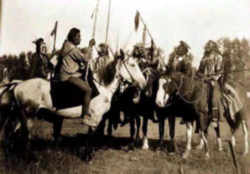


Washington Early History
First Early Inhabitants of Washington

Early history examines the archaeological record that tells the story of the first inhabitants of Washington. Learn about the prehistory and culture of the first early inhabitants, and what lessons it might teach us about the early history of Washington.
Washington First Early Inhabitants Timeline
- 40-17 million years ago - The Cascade Mountains are formed. The Olympic Mountains appear as islands in the Pacific.
- 17-6 million years ago - Floods of lava cover the Columbia Basin and destroy the Columbia River waterway.
- 15.5 Mil - Southeastern Washington and Oregon were covered by huge lava flows estimated at some 40,000 cubic miles. Some beds were over a mile thick. The weight led to a sag in the earth and the ancient Lake Vantage formed. (ST, 7/29/04, NWW p.18)(SSFC, 9/12/04, p.D9)
- 6 million - 10,000 years ago - Washington's Ice Age. Volcanos form in the Cascades and huge glaciers cover the mountains and Puget Sound. Floods shape the southern part of the state.
- 40,000BP - Mount St. Helens was born and intermittent eruptions continued to about 500 BC. (SFEC, 8/16/98, p.A15)
- 15k-13k BCE - During the last Ice Age dams of glacial meltwater repeatedly failed and eroded land in southeastern Washington state and Oregon. This exposed petrified logs in what later became Gingko Petrified Forest State Park. An ice dam, which blocked the Clark Fork River in Montana and created lake Missoula, broke at least 40 times and caused cataclysmic floods. One Missoula flood left Portland under 400 feet of water. (CW, Fall '03, p.20)(SSFC, 9/12/04, p.D9)
- 11,000 BP - People of the Clovis Culture inhabit the Northwest.
- 7200 BC - A skeleton of about this age was found in July, 1996, by the Columbia River in Kennewick, Wa. It became known as the "Kennewick Man" or "Richland Man." The 9,200 year old bones were later studied and determined to be most closely related to Asian people, particularly the Ainu of northern Japan. It was concluded in 2000 that he was an American Indian. The bones were dated to 7514-7324 BC. (SFC, 10/16/99, p.A11)(SFC, 1/14/00, p.A7)(SFC, 9/26/00, p.A5)(Econ, 7/16/05, p.76)
- 6,700 BP - Mount Mazama erupts
- 3,600BC - The Osceola mudflow from Mount Ranier covered an area from Rainier to Puget Sound. (SFEC, 7/12/98, p.A22)
- c1400 - The 6 yard deep Electron Mudflow came down from Mount Rainier where the town of Orting was later established. (SFEC, 7/12/98, p.A22)
- 1805 - Lewis and Clark enter Washington. Female Shoshone Indian guide Sacajawea (1788-1812) acted as interpreter and negotiator
Early History of Native Americans in Washington
The Indigenous People of Washington
The names of the Washington tribes included the Chinook, Clalskanie, Columbia, Cowlitz, Makah, Nez Perce (see picture above), Ozette, Palouse, Wahkiakum, Wallawalla, Wynoochee and Yakama.
Most of present-day Washington lies under the Pacific Ocean until a giant island now called the Okanogan Terrane collides with North America about 100 million years ago. This was long before our species, Homo sapiens, evolved on Earth. A second "micro-continent" rams North America to create Western Washington and the volcanic Cascade Range about 50 million years ago. Vast flows of lava well up to create the Columbia Plateau about 15 million years ago. Ice Age glaciers begin spreading over most of Washington about two million years ago. Human beings evolve in Africa about 160,000 years ago.
Between 12,000 and 16,000 years ago, a group of nomadic hunters crossed the frozen Bering Strait from Siberia into present-day Alaska and eventually moved further south into the Pacific Northwest. Although distinct communities developed over time, all of these native groups were dependent upon the land and the water for their livelihood. Most of their lives revolved around fishing, the smoking and drying of fish, and moving across the land in search of fish. They lived in waterside villages of cedar plant houses. Another distinctive feature of these groups was their building of totem poles, which tell the stories of families, clans and individuals.
Many Native Americans lived in the Washington region when European explorers first visited the area. Some of these groups lived west of the Cascades.
The Chinook, Nisqually, Quinault, and Puyallup hunted deer and fished for salmon and clams. Others, the Cayuse, Colville, Spokane, and Nez Perce, lived
east of the Cascades on the plains and valleys.
One of the best known of the Native Americans in this area was Chief Seattle, who is believed to have born in central Puget Sound. Chief Seattle was
a member of the Suquamish people and welcomed the first European traders and settlers, eager to trade with them. Unfortunately, Seattle's efforts to
work with Europeans made some of his own people suspicious. Eventually, his people were defeated and Seattle died on a reservation.





